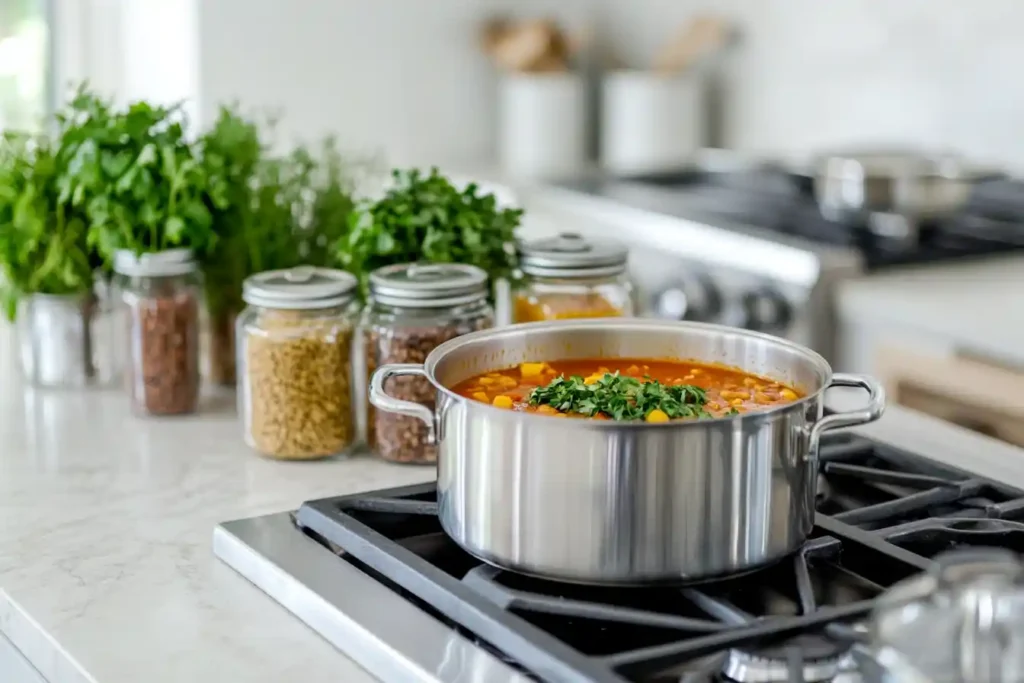The Building Blocks of Soup Flavor
The Role of Broth and Stock
Broth and stock form the backbone of most soups, offering a foundational depth that sets the stage for all other flavors. While these terms are often used interchangeably, there’s a subtle difference: stock is typically made by simmering bones for extended periods, resulting in a richer, gelatinous texture, whereas broth is lighter, crafted from simmered meat and vegetables. Both provide a canvas for adding your secret ingredient in soup.
Using high-quality broth or stock ensures a robust base. Homemade versions are always preferred, as they allow you to control sodium levels and infuse aromatics like bay leaves or thyme during the simmering process. However, if using store-bought options, choose low-sodium varieties and add your preferred seasonings later.
Significance of Aromatics
Ah, the undeniable magic of aromatics! Ingredients such as onions, garlic, celery, and carrots come together harmoniously, creating an irresistible, flavorful foundation.
This aromatic quartet forms the soul of soups, infusing depth, warmth, and complexity. Combining these ingredients creates a sensory delight.
By carefully balancing these elements, you can elevate the base of your soup, ensuring it is both rich and inviting. These ingredients aren’t just fillers; they release essential oils and sugars when sautéed, creating a flavorful base that enhances the broth.
- Common Aromatics Used in Soups: Garlic offers a pungent warmth, onions provide sweetness, and celery adds a hint of bitterness.
- Techniques for Sautéing Aromatics: A quick sauté in olive oil or butter until golden brown deepens their flavor. Avoid rushing this step; the longer you cook, the richer your soup will taste.
By layering these elements thoughtfully, you’re not just building a soup—you’re crafting an experience. Pairing a well-seasoned stock with perfectly cooked aromatics creates the ideal setting for your secret ingredient to shine.
Understanding Soup Flavor Foundations
Crafting a delicious soup is all about mastering its foundational elements. While the secret ingredient in soup plays a crucial role, the base and aromatics set the stage for every other flavor to shine. Let’s delve into these essential building blocks.
Role of Broth and Stock
A good broth or stock serves as the very soul of a soup, providing it with essential depth, richness, and character. Without this strong, flavorful base, even the finest ingredients may struggle to achieve their full potential, leaving the dish lacking in balance and harmony.
By starting with a well-prepared stock, you create a foundation that elevates every other element of the soup, ensuring a satisfying and cohesive final dish.
Differences Between Broth and Stock
While broth and stock are often confused, they serve slightly different purposes.
- Stock: Made by simmering bones, often with minimal seasonings, stock delivers a velvety texture thanks to the gelatin released from the bones. It’s ideal for creamy or hearty soups that require body.
- Broth: Created by simmering meat and vegetables, broth is lighter, more flavorful, and often seasoned. It’s perfect for clear soups or recipes where the focus is on other ingredients.
Importance of Quality Base
The quality of your base directly impacts the soup’s outcome. Opting for homemade stock or broth allows for more control over salt levels and flavor nuances. For store-bought options, low-sodium varieties are your best bet. Boost their flavor with herbs like thyme, parsley, or a bay leaf as you cook.
Significance of Aromatics
The aromatic ingredients are what breathe life into a soup. These include vegetables and herbs that release their essence during cooking, layering the flavors beautifully.
Common Aromatics Used in Soups
- Onions: A foundational sweet-savory flavor.
- Garlic: Adds warmth and complexity.
- Celery: Offers a slightly bitter, earthy note.
- Carrots: Contribute sweetness and a vibrant color.
Techniques for Sautéing Aromatics
To unlock the full potential of aromatics, sautéing is key. Heat a bit of olive oil or butter over medium heat, then cook the aromatics until they soften and release their natural oils. This step caramelizes the sugars, resulting in a deeper, sweeter flavor.
Taking the time to perfect these foundational elements ensures that every layer of your soup—from the base to the final flourish—delivers a harmonious and unforgettable taste.
The Secret Ingredient Revealed
Every great soup has something that makes it memorable—a flavor that lingers on the palate, elevating the dish from ordinary to extraordinary. That’s where the secret ingredient in soup comes in. Often, this magic lies in a single concept: umami, the fifth taste.
Umami – The Fifth Taste
Definition and Sources of Umami
Umami, a Japanese term meaning “pleasant savory taste,” is considered the fifth basic taste alongside sweet, salty, sour, and bitter. It’s the deeply satisfying flavor you find in aged cheese, grilled meats, or ripe tomatoes. This taste comes from naturally occurring compounds like glutamates and nucleotides, found in a variety of ingredients.
Common sources of umami include:
- Fermented products (like soy sauce or miso paste)
- Cooked or dried mushrooms
- Aged or cured foods (e.g., Parmesan cheese or anchovies)
- Slow-roasted vegetables
Impact of Umami on Soup Flavor
Adding umami enhances the depth and richness of your soup, amplifying other flavors and creating a harmonious blend. It transforms a simple broth into a mouthwatering experience, making every spoonful more satisfying. By incorporating umami-rich ingredients, you can achieve that irresistible savory note that keeps people coming back for more.
Common Umami-Rich Ingredients
When searching for the secret ingredient in soup, you’ll often find it among these umami-packed options:
Miso Paste
This fermented soybean paste is a powerhouse of umami. A small dollop added to your soup can provide a salty, savory kick with a slightly nutty flavor. It’s particularly effective in broths, vegetable soups, or noodle-based dishes.
Fish Sauce
A little goes a long way with this potent liquid made from fermented fish. It’s perfect for adding depth to clear soups, broths, or even cream-based recipes. For those hesitant about its aroma, fear not—it mellows beautifully during cooking, leaving only a savory complexity.
Soy Sauce
A versatile ingredient, soy sauce brings salty, umami-rich goodness to almost any soup. Use light soy sauce for clear broths or dark soy sauce for thicker, heartier soups.
Mushrooms
Dried or fresh mushrooms, particularly shiitake or porcini, are loaded with umami. They’re a fantastic option for vegetarian soups, as they add a meaty flavor without the meat.
Tomatoes
Ripe or roasted tomatoes are a natural umami booster. Their concentrated flavor makes them ideal for soups like tomato bisque or vegetable minestrone.
With umami as your culinary guide, the possibilities for creating standout soups are endless. Incorporating just one or more of these ingredients can transform your dish into a savory delight.
Enhancing Soup with Acidity
While umami creates depth and richness, acidity adds brightness and balance, lifting flavors to make your soup truly vibrant. Without it, soups can taste flat or overly heavy. Let’s explore how acidic components can transform your dish.
Balancing Flavors with Acidic Components
Adding acidic ingredients is an art—it’s about enhancing the soup’s flavor without overpowering it. Acidity balances rich, creamy, or savory soups, cutting through heaviness and bringing harmony to the dish.
Lemon Juice
Lemon juice is a versatile and natural source of acidity. A splash added toward the end of cooking can brighten vegetable-based soups, chicken broths, or even creamy chowders. The citrusy tang wakes up the palate and makes each bite feel fresher.
Vinegar Varieties
Vinegar offers a wide range of flavors depending on the type you choose:
- White vinegar provides sharp, clean acidity, great for clear broths.
- Apple cider vinegar adds a subtle fruity note, ideal for hearty vegetable soups.
- Balsamic vinegar, with its sweet undertones, works wonderfully in tomato-based or lentil soups.
Timing and Techniques for Adding Acidity
Acidic ingredients should generally be added toward the end of cooking. Heat can dull their brightness, so it’s best to adjust the acidity right before serving. Start with small amounts—taste and tweak until the flavors feel balanced. This approach ensures the acidity complements, rather than overwhelms, the soup’s natural flavors.
Incorporating Fresh Herbs and Spices

Herbs and spices serve as the final, essential touch to a culinary masterpiece, adding depth, aroma, and a burst of character.
By carefully selecting and incorporating these elements, you can enhance the overall complexity of flavors, elevate the aroma to a tantalizing level, and infuse your soup with a unique personality that reflects your creativity.
Selection of Fresh Herbs
Fresh herbs are a go-to for adding vibrant, garden-fresh notes to soups. Each herb offers a unique character:
Parsley, Thyme, and Basil
- Parsley: Adds a mild, grassy flavor that complements most broths.
- Thyme: Aromatic and earthy, it works beautifully in hearty soups like chicken noodle or lentil.
- Basil: Sweet and peppery, perfect for tomato-based soups or lighter broths.
Spice Blends for Depth of Flavor
Spices provide warmth and complexity, layering flavors in subtle yet impactful ways.
Cumin, Coriander, and Paprika
- Cumin: Adds a smoky, nutty essence to lentil or bean soups.
- Coriander: Bright and citrusy, perfect for balancing heavier soups.
- Paprika: Brings a mild sweetness or smokiness depending on the variety, ideal for stews and chowders.
Timing for Adding Herbs and Spices
The timing for herbs and spices can make or break your soup:
- Early Additions: Woody herbs like thyme or bay leaves are best added early to infuse the broth.
- Late Additions: Delicate herbs like parsley and basil should be stirred in just before serving to retain their freshness.
- Layering Spices: Toast spices briefly in oil before adding liquid to amplify their flavor.
By mastering the balance of acidity and the use of herbs and spices, your soup can reach new levels of flavor complexity and freshness.
The Impact of Fat Components
Fats play a crucial role in soup-making, not just for their ability to enhance flavor but also for the luxurious texture they bring. When used correctly, fats can transform a thin, one-note soup into a velvety, satisfying dish that coats the palate with richness.
Types of Fats Used in Soups
Fats come in various forms, each bringing its unique qualities to the table.
Olive Oil, Butter, and Cream
- Olive Oil: A drizzle of high-quality extra virgin olive oil adds a fruity, peppery finish, perfect for vegetable soups or Mediterranean-inspired recipes.
- Butter: Adds a comforting, creamy richness, especially in chowders or bisques. A small knob melted into the soup at the end can round out the flavors beautifully.
- Cream: Heavy cream or half-and-half creates indulgence, ideal for pureed soups like butternut squash or tomato bisque.
Techniques for Incorporating Fats
Adding fats at the right time and in the right way ensures their best qualities shine.
Finishing Soups with a Fat Drizzle
A finishing drizzle of olive oil, cream, or melted butter just before serving can elevate the presentation and flavor profile. For an extra touch, swirl the fat into the soup to create visual appeal and ensure even distribution.
Balancing Fat with Other Elements
An excess of fat can easily overwhelm a dish, causing it to feel overly greasy or unpleasantly heavy. To counter this, pair fats thoughtfully with a touch of acidity, such as lemon juice or vinegar, which helps brighten the flavors.
Additionally, incorporating fresh herbs, like parsley or thyme, balances the richness and ensures the overall taste remains vibrant and enjoyable. For example, a creamy soup benefits greatly from a squeeze of lemon or a handful of chopped parsley.
Texture Variations in Soup

Texture can be as important as flavor when it comes to crafting the perfect soup. A well-balanced texture adds layers of interest, making each bite more engaging.
Adding Crunch with Toppings
Crunchy toppings provide contrast to smooth soups, creating a delightful interplay of textures.
Croutons, Nuts, and Seeds
- Croutons: Homemade or store-bought, these add a satisfying crunch to creamy soups.
- Nuts: Toasted almonds, cashews, or walnuts bring a nutty flavor and crisp bite.
- Seeds: Pumpkin or sunflower seeds add a subtle earthiness, perfect for autumnal soups.
Achieving Creaminess Without Dairy
For those avoiding dairy, there are plenty of ways to achieve that velvety texture:
Pureeing Vegetables and Legumes
- Vegetables: Starchy vegetables like potatoes or cauliflower, when blended, create a natural creaminess.
- Legumes: Lentils, chickpeas, or white beans can be pureed into the soup for a rich, smooth consistency.
Combining creamy and crunchy textures ensures a well-rounded sensory experience that keeps your soup exciting from the first spoonful to the last.
Global Inspirations for Secret Ingredients
Nutritional Information of Soup (Per 100g)
| Nutrient | Amount |
|---|---|
| Calories | 50 kcal |
| Protein | 2 g |
| Fat | 2 g |
| Carbohydrates | 7 g |
| Fiber | 1 g |
| Sodium | 200 mg |
| Vitamin C | 4% DV |
When it comes to uncovering the secret ingredient in soup, inspiration often lies in diverse culinary traditions. Throughout the world, cultures have skillfully mastered the art of infusing soups with distinctive flavors, thereby crafting dishes cherished by many. Moreover, by thoughtfully incorporating global ingredients into your cooking, you can effortlessly transform your soup, while also adding layers of complexity and depth. Consequently, these elements work together to elevate your creation to a completely new level of deliciousness, ensuring a memorable dining experience.
Asian Influences
Asian cuisines, for instance, excel at layering umami-rich flavors and delicate aromas, which combine harmoniously to create extraordinary dishes. Moreover, these ingredients can effortlessly and instantly elevate any soup, adding both depth and complexity to its overall flavor profile.
Kombu and Dashi
- Kombu: A type of edible kelp, kombu is a powerhouse of umami. It’s commonly simmered in water to create a deeply savory broth base for Japanese miso soup.
- Dashi: A light stock made with kombu and bonito flakes, dashi forms the heart of many Japanese soups. Its clean, briny flavor enhances the subtle flavors of vegetables and tofu.
Mediterranean Additions
The Mediterranean region offers bold, flavorful ingredients that can take soups to the next level.
Olive Tapenade and Pesto
- Olive Tapenade: This paste of olives, capers, and anchovies adds a salty, briny depth to tomato or vegetable soups.
- Pesto: A spoonful of pesto, made with fresh basil, pine nuts, and Parmesan, can transform a simple broth into a vibrant, herbaceous dish.
Latin American Touches
Latin American cuisines are known for their bold flavors and zesty accents, perfect for spicing up soups.
Cilantro and Lime
- Cilantro: This fresh herb adds a bright, citrusy note to soups like tortilla soup or black bean stew.
- Lime: A squeeze of lime juice not only balances rich, spicy broths but also enhances their natural flavors, making each spoonful more refreshing.
Common Mistakes to Avoid
Making soup might seem straightforward, but even seasoned cooks can fall into traps that diminish its flavor and texture. By understanding these common mistakes, you can ensure your soups consistently turn out flavorful and well-balanced.
Overuse of Salt
Salt is essential for seasoning, but too much can overwhelm other flavors. If your soup becomes overly salty:
- Add a starchy ingredient like potatoes or rice to absorb some of the excess salt.
- Balance it with a splash of vinegar or lemon juice, which can counteract the saltiness.
Always season gradually and taste as you go to avoid over-salting.
Ignoring Flavor Balance
A soup without balance is like a song out of tune. Neglecting to incorporate acidity, sweetness, or umami can leave the dish one-dimensional.
- Acidity: A squeeze of lemon or a splash of vinegar can brighten the flavors.
- Sweetness: A pinch of sugar or a drizzle of honey can offset bitterness in tomato or vegetable soups.
- Umami: Ingredients like mushrooms, soy sauce, or Parmesan cheese add depth.
Underseasoning and Its Effects
On the other hand, underseasoning can result in bland soup. Even with quality ingredients, insufficient salt or spices dulls the flavor. Always season in layers—add salt early for the broth, but adjust again at the end for the perfect finish.
Frequently Asked Questions About ingredient in soup
To help you perfect your soup-making skills, here are answers to some of the most common questions about preparing soups and enhancing their flavors.
The most important ingredient in soup is its base, typically a high-quality broth or stock. A flavorful base sets the stage for every other ingredient to shine. Beyond that, adding a secret ingredient in soup, such as an umami booster like miso paste or fish sauce, can elevate the overall flavor.
Vinegar adds acidity, which balances rich or heavy flavors in soups. A small splash can brighten the dish, bringing out subtle notes that might otherwise be overshadowed. It’s especially effective in cream-based or bean soups, where it counteracts richness.
Umami can be boosted by incorporating ingredients such as soy sauce, miso paste, dried mushrooms, tomatoes, or Parmesan cheese. These elements add savory depth and make your soup more satisfying.
Vegetarian options for umami include:
Dried mushrooms (e.g., shiitake or porcini)
Nutritional yeast
Roasted tomatoes
Seaweed (e.g., kombu)
These ingredients pack a savory punch without using animal products.
Conclusion: The Secret to Perfect Soup
Creating the perfect soup requires balance, layering flavors, textures, and techniques. Whether starting with a rich broth, adding umami-packed ingredients, or finishing with a touch of acidity and fresh herbs, every element contributes to the final dish. Ultimately, the true secret ingredient in soup is the care and creativity you bring. So, experiment confidently, trust your taste, and savor the art of soup-making!

